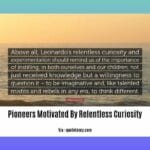In “Innovative Minds Who Disrupted Arts and Communication: Unlocking the Power of Transformation,” we delve into the captivating stories of individuals who dared to challenge conventions and revolutionize the landscape of arts and communication. Their groundbreaking ideas and relentless pursuit of innovation have reshaped the way we experience and interact with the world, leaving an enduring mark on our cultural fabric.
Key Takeaways:

- Creativity involves the interconnectedness of neurons, with innovative minds exhibiting unique neural patterns.
- Six key mindsets essential for creative thinking include curiosity, collaboration, embracing mistakes, experimentation, persistence, and playfulness.
- Science-based strategies for enhancing creativity include imagining vivid scenarios, brainstorming in a focused environment, and seeking inspiration from diverse sources.
- Innovation in creative industries encompasses novel products or services that challenge expectations, with definitions varying based on assimilation and differentiation approaches.
- Innovation is often driven by tacit agreements between managers and clients, while crowd innovation plays a significant role in cultural organizations.
- Digital platforms empower artists through earnings tracking and income generation opportunities, also making the creative industries an investable sector in emerging markets.
Innovative Minds Who Disrupted Arts and Communication
Innovative minds who disrupted arts and communication, like Andy Warhol and Steve Jobs, challenged the status quo and revolutionized their respective fields. They did this by:
Questioning norms: They didn’t accept the “way things have always been done” and instead sought new and innovative approaches.
Experimenting fearlessly: They weren’t afraid to take risks and try new things, even if they failed.
Embracing technology: They leveraged new technologies to create groundbreaking work that wouldn’t have been possible otherwise.
Collaborating cross-disciplinarily: They worked with people from different fields to gain fresh perspectives and create truly unique projects.
Ignoring critics: They didn’t let negative feedback stop them. Instead, they continued to believe in their vision and push boundaries.
By pushing boundaries and challenging conventions, these innovative minds forever changed the landscape of arts and communication. Their legacies continue to inspire and empower artists and communicators today.
Discover the pioneers who revolutionized entertainment and media and their groundbreaking contributions. Explore how trailblazers who transformed content and delivery shaped the industry, and learn about the entertainment and media sector’s great disruptors who challenged the status quo.
Ai Weiwei: Art as Activism and Sociopolitical Commentary
To truly understand the transformative power of art, look no further than Ai Weiwei, a Chinese artist renowned for his provocative works that challenge authority and shed light on social issues.
Weiwei’s art, often rooted in Western Conceptual and Minimalist styles, uses simple gestures to convey potent messages. His work has relentlessly criticized the Chinese government’s human rights abuses and lack of transparency.
Despite persecution, including the destruction of his studio and detention of his staff, Weiwei remains defiant in using his art as a platform for raising awareness and advocating for social justice.
Key Takeaways:
- Weiwei’s art challenges authority, raising awareness of social issues.
- He fearlessly criticizes the Chinese government’s human rights record.
- Despite persecution, he uses his art to advocate for social justice.
Most Relevant URL Source:
Marina Abramović: Performance Art as Exploration of Boundaries and Identity
Performance art pioneer Marina Abramović has pushed the limits of artistic expression, inviting audiences to confront their own boundaries and question their identities. Her groundbreaking performances have challenged norms, sparked dialogue, and left an indelible mark on the art world.
Early Life and Artistic Journey:
Marina Abramović was born in Belgrade, Yugoslavia (now Serbia) in 1946. Influenced by her childhood experiences, she pursued a conceptualist approach, prioritizing ideas over traditional forms. In the 1970s, she began collaborating with artist Ulay, forming a dynamic partnership that explored interpersonal dynamics and physical endurance.
Notable Performances:
“Rhythm 0” (1974): In this shocking performance, Abramović invited audience members to do whatever they wished to her body for six hours. The result was a harrowing exploration of the limits of human cruelty and the potential for violence within seemingly civilized societies.
“Balkan Baroque” (1997): Inspired by the horrors of the Bosnian War, Abramović recreated a scene of carnage, using blood and bones to evoke the pain and suffering inflicted by ethnic violence.
“The Artist Is Present” (2010): This captivating performance saw Abramović sitting silently opposite visitors for up to eight hours a day, inviting them to engage in an intense eye-to-eye connection. It became a profound exploration of empathy, vulnerability, and the power of shared experiences.
Key Takeaways:
- Challenged artistic conventions: Abramović pushed the boundaries of performance art, redefining what is considered acceptable and thought-provoking.
- Explored the human condition: Her performances delved into the depths of human nature, examining vulnerability, pain, and the limits of physical and mental endurance.
- Created emotionally charged experiences: Abramović’s work invited audiences to confront their own emotions and prejudices, sparking powerful reactions and creating lasting memories.
- Blurred the line between artist and audience: Through her interactive performances, Abramović actively involved the audience, collapsing the traditional barrier between performer and spectator.
Citation:
My Modern Met. (2023, January 19). Marina Abramović: Performance Artist Who Explores Pain, Endurance, and Identity. [Website].
Banksy: Street Art as Social Commentary and Subversion
Banksy: the artistic rebel whose street art serves as a potent visual commentary on the world’s social and political ills. With spray cans as his weapon and urban walls as his canvas, he challenges societal norms, exposes injustices, and sparks crucial conversations.
Through stencils and murals, Banksy masterfully conveys thought-provoking messages. His works unveil the absurdities of war, the hypocrisy of the powerful, and the plight of the marginalized. By engaging the public in his artistic dialogue, he incites both admiration and controversy, forcing us to confront uncomfortable truths.
In his iconic “Flower Thrower” piece, a masked protester defiantly hurls flowers instead of rocks, symbolizing the power of peaceful resistance against oppression. The “Cardinal Sin” graffito, depicting a Catholic cardinal holding a skull, exposes the Church’s involvement in the child abuse scandal. And “I Remember When This Was Trees,” a stark portrayal of a barren landscape, highlights the devastating impact of environmental degradation.
Banksy‘s art serves as a catalyst for change, raising awareness, inspiring activism, and pushing us to question the status quo. His street art becomes a platform for the voiceless, a powerful reminder that art can be more than just decoration—it can be a transformative force in society.
Key Takeaways:
- Banksy is renowned for his thought-provoking street art that confronts social and political issues.
- His works challenge societal norms, expose injustices, and spark crucial conversations.
- Through stencils and murals, he conveys potent messages that resonate with global audiences.
- Banksy‘s art serves as a catalyst for change, raising awareness and inspiring activism.
- He utilizes urban walls as his canvas, making his art accessible to a vast public.
Most Relevant URL Source:

FAQ
Q1: How does neuroscience contribute to our understanding of creativity?
A1: Neuroscience has revealed the interconnectedness of neurons during creative processes, showing that innovative minds exhibit unique neural patterns.
Q2: What six key mindsets foster creative thinking?
A2: The six key mindsets that foster creative thinking are curiosity, collaboration, embracing mistakes, experimenting, persistence, and playfulness.
Q3: Can you explain the three science-based strategies for enhancing creativity?
A3: The three science-based strategies for enhancing creativity are imagining vivid scenarios, brainstorming in a focused environment, and actively seeking inspiration from diverse sources.
Q4: How does innovation manifest in the creative industries?
A4: Innovation in the creative industries involves creating novel products or services that challenge expectations, with definitions varying across different sectors.
Q5: What are some key determinants of innovation in cultural organizations?
A5: Determinants of innovation in cultural organizations include tacit agreements between managers and clients, as well as the increasing significance of crowd innovation.
- Discover Long Black Pepper: Flavor & Health Benefits - April 25, 2025
- Shocking Twists: The Grownup Review: Unreliable Narration - April 25, 2025
- A Quiet Place Book vs Movie: A Deep Dive - April 25, 2025
















